In Concurrent engineering product design methodology, different departments simultaneously work on different stages of engineering product development. Concurrent engineering is an approach developed in the 1980s to eliminate some of the issues with the ‘over the wall’ method.
Contents covered in this article
What is concurrent engineering?
Concurrent engineering is a method of designing and developing engineering products in which different departments simultaneously work on the different stages of engineering product development. If managed well, it helps to increase the efficiency of product development and marketing, considerably reducing the time and contributing to the reduction of the overall development cost while improving the final product quality.
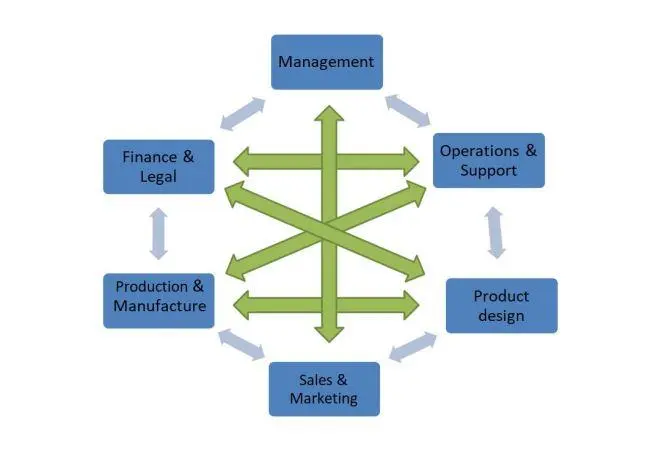
Some key activities during concurrent engineering
- Management: Leadership, resource allocation, risk management.
- Operations and Support: Process optimization, logistics, feedback loop.
- Product Design: Cross-functional collaboration, prototyping, compliance.
- Sales & Marketing: Market research, product positioning, customer engagement.
- Production & Manufacture: Design for manufacturability, quality control, scalability.
- Finance and Legal: Budgeting, cost analysis, IP management, compliance.
This streamlined approach towards an engineering product forces several teams within the organisation, such as product design, manufacturing, production, marketing, product support, finance, etc., to work simultaneously on new product development.
For instance, while engineering product designers begin to design the product, the sales team can start working on the marketing, and the product support department can start thinking about the after-sale support. While the mechanical designers work on the packaging design to incorporate the PCB developed by the electrical engineering team, the software engineers can start looking at the software code.
Concurrent engineering, also known as integrated product development (IPD) or simultaneous engineering, was introduced a few decades ago to eliminate the issues from sequential engineering or the so-called “over the wall” process. This systematic approach is intended to force all the stakeholders to be involved and the full engineering product cycle to be considered from concept to after-sale support. There are plenty of incentives to choose Concurrent engineering over sequential engineering product development.
The popularity of integrated product development has grown recently, thanks to the ever-increasing demand for expeditiously quality products at affordable prices.
Although managing a simultaneous engineering process is very challenging, the techniques and practices followed as part of concurrent engineering benefit from several competitive advantages to the company and to the final engineering product itself.
Elements of concurrent engineering
Concurrent engineering presents an environment that encourages and improves the interaction of different disciplines and departments towards a single goal of satisfying engineering product requirements. A PPT framework or the Golden Triangle can summarise key elements of concurrent engineering.
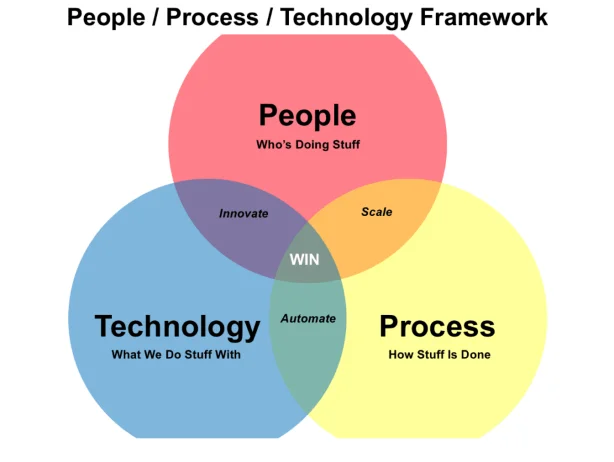
People, processes, and technology are crucial to any organisation and essential in implementing concurrent engineering to achieve shorter development time, lower cost, improved product quality and fulfil customer needs.
People
Concurrent product development is a multidisciplinary team task, and companies must utilise the right skilled personnel at the right time to accelerate product development. It is also necessary to find people with the right skills and experience along with the following key aspects;
- Multidisciplinary team to suit the product at the start of the NPD
- Teamwork culture at the core of the program
- Good communication and collaboration between teams – sharing relevant and up-to-date information across departments and personnel
- The harmonized goal across the company from the top management to the bottom of the organizational structure
Process
A process is a series of product development steps that need to happen to achieve a goal. These can be project planning stages, milestone management, problem-solving methodologies, product development key stages, information sharing workflow, etc., as people are ineffective without processes to support their tasks and decisions. Following are some of the processes that can be adopted in concurrent engineering;
- Project planning processes and workflow management include key new product development elements such as key design stages, milestones for cross-departmental interaction, etc.
- Workflow for product data management includes sharing information, managing engineering change, controlling specification creep, etc.
- Product requirement tracking and checkpoints using techniques such as Quality Function Deployment (QFD) across departments
- Design evaluation workflow processes
- Design analysis methodologies such as brainstorming
- Failure Mode and Effects Analysis (FMEA) allows for a systematic investigation of the occurrence and impact of possible flaws in the new product design.
- The use of Design of Experiments (DOE) enables the systematic identification of critical product/process parameters that influence performance.
Technology
For concurrent engineering to be successful, the effective introduction of tools, techniques, and technologies to aid a smooth integration of people and processes is vital. The following key aspects should be considered before any implementation.
- Identifying the correct tools and technologies that suit the company size, number of team members, processes implemented and product type
- Identifying the training needs and training people to use the tools and technologies identified above
These are just a few supportive tools that can be used in a concurrent engineering environment.
- Project management software
- Product data management & product lifecycle management suites
- Quality Function Deployment (QFD)
- 3D CAD and rapid prototyping technologies, such as additive manufacturing
- Suitable FEA tools
- Evaluation tools such as DFM, DFA, DFMA and DOE
- Failure mode analysis tools such as FMEA
Concurrent new product development
A new product cycle can be decreased significantly by concurrently engaging in multiple aspects of design and development phases across the PPT framework. The figure below shows a typical new product development cycle with examples of concurrent activities and functions discussed above.
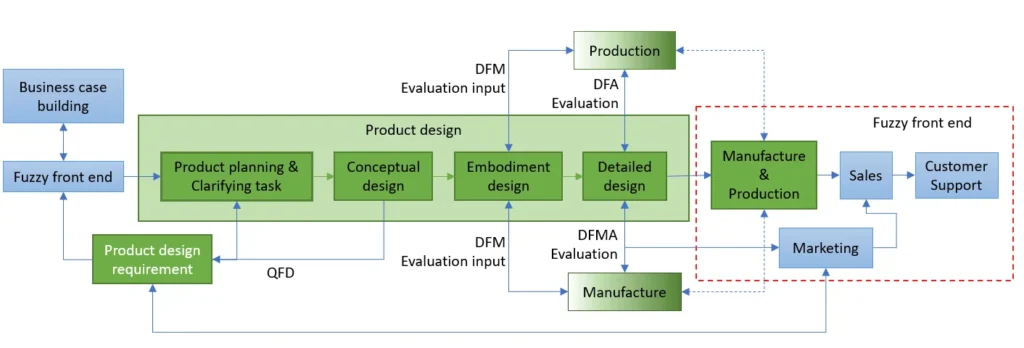
Examples of concurrent new product development activities:
- Management consults experts from different disciplines to define a product design specification (PDS) jointly. Tools such as QFD can be used to track product requirements across departments during the initial product development stages.
- During the embodiment design stage, manufacturing is consulted to evaluate the design’s manufacturability by using tools such as DFM, QFD and DFMA.
- Production is consulted to evaluate the design for assembly, which would flag up issues with an assembly, including the requirement of tools and jigs. Tools such as design for assembly (DFA) can be used to analyse the design.
- Sharing design information with production at the detailed design stages of the process would enable them to get the tools and production jigs ready for production.
- At the final stages of the design, the design team shares information such as final specifications with sales and marketing teams enabling them to prepare datasheets, brochures, package design, promotional events, etc.
- Sharing the latest information across the team in a controlled central manner is crucial at all stages.
Advantages and disadvantages of Concurrent engineering
Advantages of concurrent engineering
- It encourages multi-disciplinary collaboration
- Reduces product cycle time
- Reduces cost
- Increases quality by supporting the entire project cycle – enhanced quality.
- Increases productivity by stopping mistakes in their tracks
- It gives a competitive edge over the competitors
Disadvantages of concurrent engineering
- Complex to manage
- It relies on everyone working together; hence communication is critical
- Room for mistakes is small as it impacts all the departments or disciplines involved
Concurrent engineering is a powerful workflow methodology, if implemented correctly, that will positively impact product quality and the objectives of the company. However, each company has no one-size-fits-all methods or procedures, and product development will differ. Hence, catering and putting a suitable system in place across the PPT framework is crucial to the success and a challenge faced by product managers.
Concurrent and sequential engineering are the two main product design workflow approaches companies to use to interact with functional teams to share information during the eight stages of new product development.
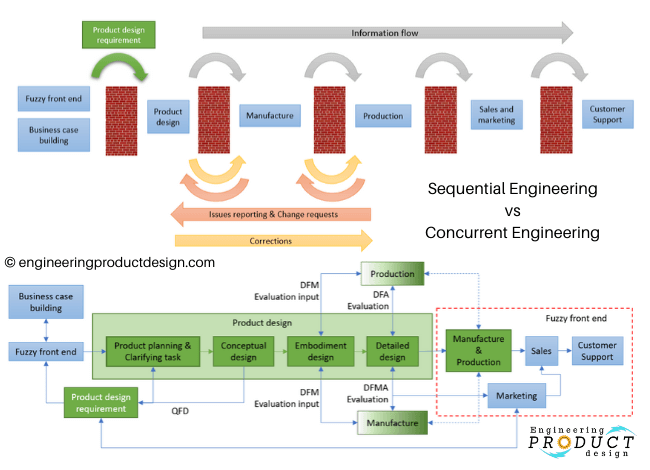
Any product development is time-consuming, and the technology involved to create modern-day products are very complex. Companies can no longer rely on a few engineers to design, develop, and then launch them. The industrial revolution and subsequent continuous technological advancements in many areas have forced people to specialise in a field, which has made companies hire specialised employees. Modern-day new product development is a multi-disciplinary process and relies on functional teams such as, industrial designers, product designers (mechanical, electrical and software engineers), manufacturing, marketing personnel, etc., to get the product to market. Challenges facing NPD are ample. Hence, NPD fails more often than it succeeds.
How well different functional teams interact with each other when (at what stages of the development) they communicate and how well they share information would make a huge difference in their quest for a successful product. This is because these factors, in turn, affect the development time, product cost and quality of the product.
What is Sequential Engineering (SE)?
Traditional sequential engineering is the term used to describe linear product development processes, where design and development steps are carried out one after another focusing on one field of expertise at a time. During the industrial revolution, this forced companies to hire specialised people and departments due to products getting more complex. This, in turn, paved the way to an “over the wall” mentality where each team member or department only focused on their tasks and passed the completed work onto the next.
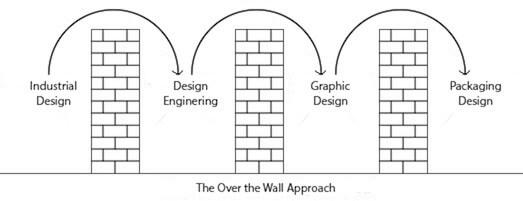
This traditional so-called “chimney” based new product development process describes a large vertical structure that only interacts downstream, with the following advantages and disadvantages.
Advantages and Disadvantages of sequential engineering
Advantages sequential engineering
- Easy to track progress and understand the requirements of the project and processes
- It is well defined for each team member or department
- Simple to understand and avoids misinterpretation
- It is an imposed disciplined approach that takes away any misunderstanding
Disadvantages of sequential engineering
- Increased product cycle time because of the rework during the latter stages of the NPD
- Change requests from others in the latter stages are often very expensive and difficult to manage
- Without staged feedback and specification evaluation gates, the product might creep out or fall short of the expectation
- Manufacturing and production costs might be too difficult and expensive making the final unit cost not economically viable
Concurrent engineering vs sequential engineering
Let us look at a typical new product development journey a company takes and explore the differences between concurrent engineering and sequential engineering.
Sequential new product development
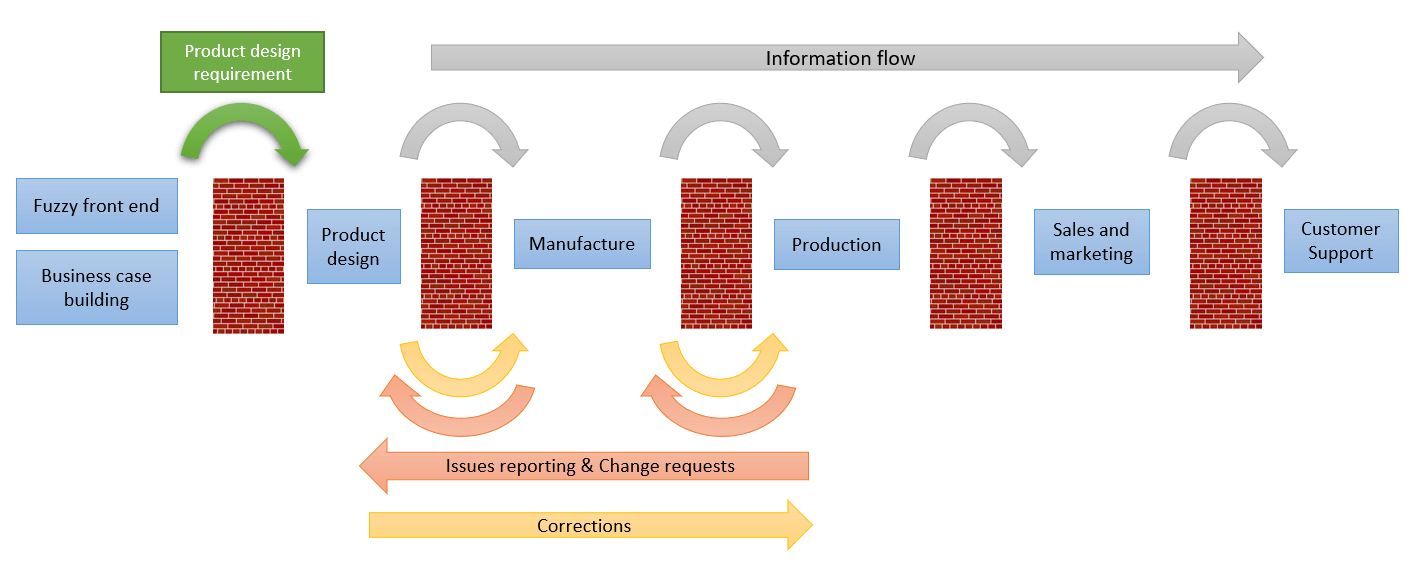
Figure shows a typical product development team and its functionality in a traditional linear workflow.
- After identifying a product development opportunity and analysing the business case during the fuzzy front end of an NPD, the management passes on a Product Design Specification (PDS) to the design and development department.
- If the product design team did not have any input during the PDS, then they will start the product development journey with blank paper. Any idea generation, evaluation and customer evaluation data does not get passed on.
- Product design is completed as per the PDS until the detailed designs are in place. Detailed drawings are then released to the manufacturing engineer. This is the stage where lots of issues get flagged up by the manufacturing department who will request changes and flag up problems with the suppliers. Any issues raised by suppliers during the procurement phase will be fed back to the design department.
- After the request and change phase, parts will be ready to be delivered to the production department for assembly and test, where more issues are flagged up on the assembly
Concurrent new product development

Same product development can be rejigged with very little extra resources to have a concurrent engineering workflow. As shown in figure below, departments consult each other or relevant personnel before finalising their task. Let us delve into the process to explore the advantages.
- The company jointly defines a product design specification (PDS).
- Manufacturing and production are consulted to evaluate the manufacturability of the design. Tools such as DFM, QFD and DFMA can be used for evaluation.
- Tools such as design for assembly (DFA) is used to evaluate the design jointly with the production
- Detailed design information is shared with production enabling them to get the tools and production jigs ready.
- Finally, the design team shares information such as final specifications with sales and marketing teams enabling them to prepare datasheets, brochures, package design, promotional events, etc.
Below is a comparative table highlighting the differences between Concurrent engineering and Sequential engineering
| Aspect | Concurrent Engineering | Sequential Engineering |
| Definition | An integrated approach where design and development processes are performed simultaneously. | A traditional approach where design and development processes are performed in a linear sequence. |
| Workflow | Parallel: Different stages overlap and are worked on concurrently. | Linear: Each stage is completed before the next begins. |
| Communication | High interaction and continuous communication between teams. | Limited interaction; communication often occurs at stage handoffs. |
| Speed | Generally faster as multiple processes are carried out simultaneously. | Slower, as each stage must be completed before moving to the next. |
| Flexibility | High flexibility; changes can be integrated quickly throughout the process. | Low flexibility; changes often require revisiting previous stages. |
| Risk | Higher initial risk due to parallel development but mitigated by early issue detection. | Lower initial risk but higher later-stage risk due to potential need for rework. |
| Cost | Potentially lower total cost by reducing time to market and avoiding rework. | Potentially higher total cost due to sequential development and possible rework. |
| Product Quality | Often results in higher quality due to continuous feedback and integration. | Quality may suffer due to limited feedback loops. |
| Design Changes | Easier to accommodate design changes throughout the process. | Difficult to implement changes; often leads to significant delays and costs. |
| Innovation | Encourages innovation through collaborative and iterative processes. | May hinder innovation due to rigid and compartmentalized processes. |
| Team Collaboration | Requires close collaboration and teamwork across disciplines. | Involves less cross-disciplinary collaboration; teams work more independently. |
| Examples of Use | High-tech industries, automotive, aerospace, and complex systems development. | Traditional manufacturing, simpler products, and industries with rigid processes. |
| Resource Utilization | Often leads to more efficient resource utilization by reducing idle time. | Resources may be idle between stages, leading to inefficiencies. |
| Problem Detection | Problems are detected earlier through concurrent review and testing. | Problems may be detected late, resulting in higher costs and delays. |
| Documentation | Requires robust documentation and version control to manage concurrent activities. | Documentation is straightforward as each stage is completed before moving to the next. |
| Overall Development Cycle | Shorter due to overlapping processes and rapid iteration. | Longer due to sequential and non-overlapping stages. |
Costing comparison of CE vs SE
In sequential engineering product development, costs increase slowly as the activities are sequentially executed by the departments as they get involved in the process. But, at the design- manufacturing phase costs increase rapidly due to change requests & iteration loops where there is a back and forth change management process.

In concurrent engineering product development, costs increase rapidly at the beginning of the development due to a larger team getting involved and intensive activities. However, as the product development progresses into manufacturing and production it gets quicker and costs decrease due to fewer issues to sort and shorter iterative loops.
Here, product design or development costs range between 5-15% of the overall product cost. But, the decision taken during the design stage affects 60-95% of the cost. This shows how crucial it is to make the right decisions during the early design stages to save the overall cost of a product.
There is plenty of real-life practical data available on savings, such as,
- How Ford motor company substantially reduced their time to market while increasing the quality of some of their cars.
- DFM, QFD, cross-functional teams supported by the top management were key to the success of HPs 34401A multimeter
There are a lot of benefits in introducing Concurrent practice into product development. It does not have to be fully comprehensive. Some of the criticism is that it needs more resources at the beginning. But done correctly, it can be minimised. Not all the departments will have to get involved from the start or at all the key stage meetings.
For companies that develop products regularly, it is worth putting some product development processes in place with defined stages.
How to implement Concurrent Engineering?
Concurrent engineering (CE) and integrated new product development (NPD) focus on simultaneous development activities and interdisciplinary collaboration to shorten the time-to-market, improve quality, and reduce costs. Concurrent Engineering interactions between the following section is key.
- Management
- Operations and Support
- Product design
- Sales & Marketing
- Production & Manufacture
- Finance and Legal

Here’s a breakdown of things to do for each section of a company during this process:
1. Management
- Leadership and Vision: Set a clear vision and goals for the new product and communicate them effectively across all teams.
- Coordination and Integration: Facilitate cross-functional team meetings and ensure effective department collaboration.
- Resource Allocation: Allocate resources (human, financial, technical) efficiently based on project needs and priorities.
- Risk Management: Identify potential risks early and develop mitigation strategies.
- Monitoring and Reporting: Implement systems for tracking progress, managing timelines, and reporting to stakeholders.
- Decision-Making: Make timely and informed decisions to resolve conflicts and remove roadblocks.
- Training and Development: Train team members on concurrent engineering principles and tools.
2. Operations and Support
- Process Optimization: Streamline processes for efficiency and support the concurrent development of multiple project aspects.
- Logistics Coordination: Ensure logistics for materials and components are synchronised with the project timeline.
- Support Services: Provide support services such as IT, maintenance, and facilities management to aid development activities.
- Feedback Loop: Create mechanisms for capturing feedback from operations to inform design and development.
- Documentation: Maintain thorough and up-to-date documentation for processes, workflows, and support activities.
- Change Management: Manage changes effectively to minimise disruption to ongoing operations.
3. Product Design
- Cross-functional collaboration: Work closely with manufacturing, marketing, and other teams to ensure the design is feasible and meets market needs.
- Concurrent Development: Use CE principles to design for manufacturability, maintainability, and other downstream processes.
- Prototyping and Testing: Develop and test prototypes iteratively to validate design concepts early.
- CAD/CAE Tools: Utilize advanced Computer-Aided Design (CAD) and Engineering (CAE) tools for design efficiency.
- User-Centric Design: Incorporate customer feedback and usability studies to refine the design.
- Design Reviews: Conduct regular design reviews with cross-functional teams to ensure alignment and address issues early.
- Compliance: Ensure design meets regulatory and industry standards.
4. Sales & Marketing
- Market Research: Conduct market research to understand customer needs, preferences, and competitive landscape.
- Product Positioning: Develop a unique value proposition and positioning strategy based on the product’s strengths and market needs.
- Feedback Incorporation: Customer and market feedback influence product features and improvements.
- Marketing Strategy: Create and implement a marketing strategy, including branding, promotion, and advertising plans.
- Sales Forecasting: Develop sales forecasts and strategies for product launch and market penetration.
- Training: Train the sales team on the new product features, benefits, and competitive advantages.
- Customer Engagement: Plan for early customer engagement activities, demos, and pilots.
5. Production & Manufacture
- Design for Manufacturability: Collaborate with the design team to ensure the product can be manufactured efficiently and cost-effectively.
- Process Development: Develop and validate manufacturing processes, including tooling, fixtures, and production workflows.
- Production Planning: Create detailed plans aligning with project timelines and market launch dates.
- Quality Control: Implement robust quality control measures and testing protocols to ensure product reliability.
- Supply Chain Coordination: Work closely with suppliers to secure raw materials and components and manage lead times.
- Lean Manufacturing: Apply lean principles to eliminate waste and improve production efficiency.
- Scalability: Plan for scalability and flexibility in the production process to accommodate potential changes in demand.
6. Finance and Legal
- Budgeting: Develop and manage the project budget, ensuring alignment with overall financial goals and constraints.
- Cost Analysis: Perform cost-benefit analyses to evaluate the financial feasibility of different design and production options.
- Funding: Secure necessary funding for development, prototyping, and production phases.
- Contract Management: Oversee contracts with suppliers, partners, and service providers, ensuring compliance with terms and conditions.
- Intellectual Property (IP): Manage IP rights, including patents, trademarks, and copyrights, and ensure the protection of proprietary technology.
- Compliance and Regulation: Ensure the product and processes comply with legal and regulatory requirements.
- Financial Reporting: Provide regular financial reports and updates to stakeholders, highlighting risks, opportunities, and financial performance.